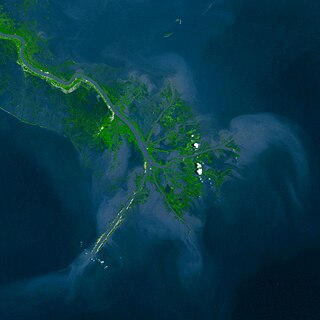Related Research Articles

Sir Charles Lyell, 1st Baronet, was a Scottish geologist who demonstrated the power of known natural causes in explaining the earth's history. He is best known today for his association with Charles Darwin and as the author of Principles of Geology (1830–33), which presented to a wide public audience the idea that the earth was shaped by the same natural processes still in operation today, operating at similar intensities. The philosopher William Whewell dubbed this gradualistic view "uniformitarianism" and contrasted it with catastrophism, which had been championed by Georges Cuvier and was better accepted in Europe. The combination of evidence and eloquence in Principles convinced a wide range of readers of the significance of "deep time" for understanding the earth and environment.

A stream bed or streambed is the bottom of a stream or river (bathymetry) or the physical confine of the normal water flow (channel). The lateral confines or channel margins are known as the stream banks or river banks, during all but flood stage. Under certain conditions a river can branch from one stream bed to multiple stream beds. A flood occurs when a stream overflows its banks and flows onto its flood plain. As a general rule, the bed is the part of the channel up to the normal water line, and the banks are that part above the normal water line. However, because water flow varies, this differentiation is subject to local interpretation. Usually, the bed is kept clear of terrestrial vegetation, whereas the banks are subjected to water flow only during unusual or perhaps infrequent high water stages and therefore might support vegetation some or much of the time.

Charles Doolittle Walcott was an American paleontologist, administrator of the Smithsonian Institution from 1907 to 1927, and director of the United States Geological Survey. He is famous for his discovery in 1909 of well-preserved fossils, including some of the oldest soft-part imprints, in the Burgess Shale of British Columbia, Canada.

Thomas George Bonney was an English geologist, president of the Geological Society of London.

Edward Hitchcock was an American geologist and the third President of Amherst College (1845–1854).

Sedimentation is the deposition of sediments. It takes place when particles in suspension settle out of the fluid in which they are entrained and come to rest against a barrier. This is due to their motion through the fluid in response to the forces acting on them: these forces can be due to gravity, centrifugal acceleration, or electromagnetism. Settling is the falling of suspended particles through the liquid, whereas sedimentation is the final result of the settling process.

James Hall Jr. was an American geologist and paleontologist. He was a noted authority on stratigraphy and had an influential role in the development of paleontology in the United States.

Israel Cook Russell, LL.D. was an American geologist and geographer who explored Alaska in the late 19th century.
Overwash is the flow of water and sediment over a coastal dune or beach crest during storm events. 'Overwash' may refer only to the landward flux of water due to overtopping of a dune system while 'washover' may refer to the sediment deposited by overwash. A common process on barrier islands, Overwash redistributes sediment and facilitates the migration of barrier islands in response to sea level rise. Overwash can occur as a result of runup, or inundation.

William John McGee, LL.D. was an American inventor, geologist, anthropologist, and ethnologist, born in Farley, Iowa.

Aggradation is the term used in geology for the increase in land elevation, typically in a river system, due to the deposition of sediment. Aggradation occurs in areas in which the supply of sediment is greater than the amount of material that the system is able to transport. The mass balance between sediment being transported and sediment in the bed is described by the Exner equation.

The Sciaridae are a family of flies, commonly known as dark-winged fungus gnats. Commonly found in moist environments, they are known to be a pest of mushroom farms and are commonly found in household plant pots. This is one of the least studied of the large Diptera families, probably due to the small size of these insects and the similarity among species.

Melas Chasma is a canyon on Mars, the widest segment of the Valles Marineris canyon system, located east of Ius Chasma at 9.8°S, 283.6°E in Coprates quadrangle. It cuts through layered deposits that are thought to be sediments from an old lake that resulted from runoff of the valley networks to the west. Other theories include windblown sediment deposits and volcanic ash. Support for abundant, past water in Melas Chasma is the discovery by MRO of hydrated sulfates. In addition, sulfate and iron oxides were found by the same satellite. Although not chosen as one of the finalists, it was one of eight potential landing sites for the Mars 2020 rover, a mission with a focus on astrobiology.

In sedimentary geology and fluvial geomorphology, avulsion is the rapid abandonment of a river channel and the formation of a new river channel. Avulsions occur as a result of channel slopes that are much less steep than the slope that the river could travel if it took a new course.
A mouth bar is an element of a deltaic system, which refers to the typically mid-channel deposition of the sediment transported by the river channel at the river mouth.
Schwenckfeldina archoica is an extinct species of dark winged fungus gnat in the family Sciaridae known from a solitary Late Oligocene to Early Miocene fossil found in Mexico. S. archoica is the only species in the genus Schwenckfeldina to have been described from fossils found in Mexican amber.
Epidapus is a genus of fungus gnats in the family Sciaridae.
Pnyxia is a genus of dark-winged fungus gnats, insects in the family Sciaridae. There are at least four described species in Pnyxia.
The Council on Undergraduate Research (CUR) is a membership organization founded in 1987 that supports the activity of undergraduate research. It sponsors various activities and events at campuses around the US to enhance the undergraduate research capacity of both faculty and students. Its office, staffed by an executive director and support staff, is in Washington, DC.

Bradysia is a genus of fungus gnat in the family Sciaridae. They are commonly known as darkwinged fungus gnats. They are considered a major pest in greenhouse agriculture because they thrive in the moist conditions common inside greenhouses and feed on the plants being grown within. Bradysia is a large genus containing over 500 living species, with at least 65 species found in North America and 172 in Europe.
References
- ↑ "David Mohrig". Google Scholar . Retrieved December 10, 2013.